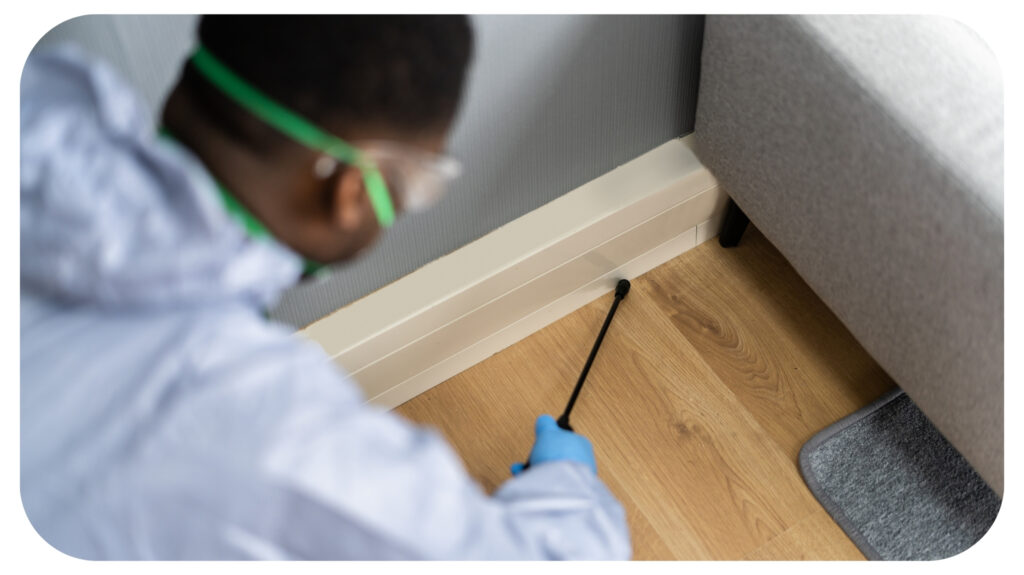6 Hidden Pest Problems That a Pre-Purchase Inspection Can Detect

Buying a home is an exciting yet complex process. While most buyers focus on the price, location, and aesthetics of a property, many overlook a critical aspect—hidden pest problems. Standard building inspections may reveal structural issues, but they often fail to uncover infestations that could lead to costly repairs and long-term property damage. Pests such as termites, rodents, cockroaches, bed bugs, possums, and birds can remain hidden within walls, under floors, and in roof spaces, causing severe damage without any immediate signs. This is why a Pre-Purchase Pest Inspection is essential before finalising a property purchase.
Hidden pest problems can significantly impact the value of a home. Termites can silently destroy wooden structures, rodents chew through wiring and insulation, and cockroach infestations pose serious health risks. Bed bugs can make living conditions unbearable, while birds and possums nesting in the roof can cause long-term maintenance issues. A thorough Termite Pest Inspection and general pest assessment can help detect these problems early, allowing buyers to make informed decisions, negotiate treatment costs, or even reconsider their purchase if the infestation is severe.
1. Termite Infestation and Structural Damage
Termites are one of the most destructive pests in Australia, responsible for millions of dollars in damage to homes each year. Unlike other pests, termites work silently, feeding on timber structures from the inside out. This means that by the time visible damage appears, significant destruction has already occurred. Termites thrive in moist conditions and are often found in wall cavities, under floors, and in roof spaces, making them difficult to detect without a professional Termite Pest Inspection.
A termite inspection identifies key warning signs such as mud tubes along walls, hollow-sounding timber, and discarded wings from swarmers. Moisture levels in certain areas of the home can also indicate a higher risk of infestation. Because most home insurance policies do not cover termite damage, detecting an infestation before purchase is critical. A Pre-Purchase Pest Inspection provides buyers with the assurance that their new home is free from active termite colonies, preventing costly repairs and ensuring the structural integrity of the property.
2. Rodent Problems in Walls and Roof Spaces
Rodents, including rats and mice, are notorious for causing damage to homes by gnawing through electrical wiring, insulation, and wooden structures. They are also carriers of harmful bacteria and diseases, posing a health risk to residents. Rodents typically nest in hidden areas such as roof spaces, wall cavities, and beneath floorboards, making them difficult to detect during standard property inspections. Their nocturnal nature means that even if a property appears rodent-free during a daytime visit, a severe infestation may already exist.
A Pre-Purchase Pest Inspection helps identify signs of rodent activity, including gnaw marks on electrical wires and furniture, droppings in roof spaces, and small holes or gaps around the home that could serve as entry points. Scratching sounds at night and an unusual odour in confined spaces may also indicate rodent presence. Left untreated, a rodent infestation can lead to expensive electrical repairs and ongoing pest control issues. Detecting this problem before buying a home allows the buyer to negotiate necessary pest control treatments or request repairs before settlement.
3. Cockroach Infestations in Kitchens and Bathrooms
Cockroaches are among the most resilient pests, capable of surviving in harsh conditions and multiplying rapidly. They are commonly found in warm, damp areas such as kitchens, bathrooms, and basements, where they hide in cracks, drains, and behind appliances. Because they are nocturnal, their presence is often not noticed until the infestation has become severe. Cockroaches pose significant health risks as they contaminate food, spread bacteria, and trigger allergies and asthma.
A Pre-Purchase Pest Inspection is essential for identifying cockroach infestations before buying a property. Inspectors check for common signs such as droppings, egg cases, and an unpleasant musty odour. They also inspect areas where cockroaches are likely to hide, such as under sinks, inside cupboards, and around kitchen appliances. If an infestation is detected, professional pest control measures will be necessary before moving into the home. Ignoring this issue can lead to ongoing pest problems that require repeated treatments and can impact the overall hygiene and liveability of the property.
4. Bed Bug Infestations in Bedrooms and Furniture
Bed bugs are a growing problem in residential properties, yet they often go unnoticed until they become a major issue. Unlike other pests, bed bugs do not cause structural damage, but their presence can make living conditions extremely uncomfortable. These tiny, blood-feeding insects hide in mattresses, bed frames, furniture, carpets, and cracks in walls. They are difficult to spot due to their small size and ability to remain hidden during the day.
A Pre-Purchase Pest Inspection can help detect bed bug infestations by looking for signs such as blood spots on bedding, shed skins, small black droppings, and live insects in seams of furniture. Bed bugs are notoriously hard to eliminate, and professional extermination can be costly. If a bed bug infestation is found, buyers should factor in the cost of pest control treatments before finalising their purchase. Addressing the issue early prevents further spread and ensures a comfortable living environment.
5. Possum Nesting in Roof Spaces
Possums often seek shelter in roof spaces, attics, and wall cavities, particularly in suburban areas. While they may seem harmless, their presence in a home can lead to significant damage. Possums are nocturnal and can be extremely noisy at night, creating disturbances for homeowners. They also leave behind urine and droppings, which can cause strong odours and attract other pests such as mites and fleas.
A Pre-Purchase Pest Inspection can identify signs of possum activity, including scratching and thumping noises in the roof, damaged insulation, and entry points such as broken roof tiles or open vents. Because possums are protected under Australian wildlife laws, removing them requires professional handling. Early detection allows buyers to arrange for humane removal and preventative measures before moving in. Ensuring that all potential entry points are sealed can help prevent possums from returning in the future.
6. Bird Nesting Issues in Gutters and Roof Areas
Birds nesting in gutters, roof voids, and chimneys can lead to ongoing maintenance problems and health risks. While they may not seem as destructive as termites or rodents, their presence can cause blocked gutters, leading to water damage and leaks. Bird droppings are highly acidic and can corrode building materials, stain surfaces, and create slipping hazards on walkways and balconies. Additionally, birds often carry mites and parasites that can spread inside the home.
A Pre-Purchase Pest Inspection helps identify bird nesting issues by checking for accumulated droppings, nests in vents or gutters, and signs of infestation near the roofline. If birds are found to be nesting on the property, removal must be handled carefully, as some species are protected under Australian wildlife laws. Taking action before purchasing the home can prevent structural damage, ongoing cleaning issues, and potential health concerns associated with bird infestations.
7. The Importance of a Pre-Purchase Pest Inspection
A Pre-Purchase Pest Inspection is one of the most important steps in ensuring that a property is free from hidden infestations. Unlike a standard building inspection, which focuses on structural integrity, a pest inspection specifically targets signs of pest activity that could affect the home’s value and safety. Buyers who skip this step may face unexpected repair costs, ongoing pest control expenses, and a decrease in property value.
By identifying pest issues early, a Termite Pest Inspection and full pest assessment provide buyers with peace of mind. If pest activity is detected, buyers can negotiate for treatments before settlement or reconsider their investment if the infestation is severe. Whether purchasing an older home or a newly built property, a pest inspection is essential for protecting both the buyer’s financial investment and their long-term comfort. Investing in a thorough pest inspection ensures a safe, pest-free home and prevents costly surprises down the line.
Conclusion
A Pre-Purchase Pest Inspection is a crucial step in the home-buying process, helping to uncover hidden infestations that could lead to costly repairs and ongoing maintenance issues. Pests like termites, rodents, cockroaches, bed bugs, possums, and birds can cause structural damage, pose health risks, and reduce a property’s value. A professional Termite Pest Inspection ensures that buyers are fully informed before committing to a purchase, allowing them to negotiate treatment costs or reconsider their investment. Skipping this inspection could result in unexpected financial burdens and long-term pest problems. Investing in a comprehensive pest assessment provides peace of mind, ensuring that your new home is safe, structurally sound, and free from hidden infestations before you move in.
Frequently Asked Questions (FAQs)
1. What is included in a Pre-Purchase Pest Inspection?
A Pre-Purchase Pest Inspection involves a thorough assessment of the property to detect signs of pest infestations, including termites, rodents, cockroaches, bed bugs, possums, and birds. Inspectors check all accessible areas such as walls, floors, roof spaces, basements, and outdoor areas for pest activity, structural damage, and entry points. The report provides details on any infestations found and treatment recommendations.
2. How long does a Termite Pest Inspection take?
The duration of a Termite Pest Inspection depends on the size of the property and the extent of the inspection. On average, a pest inspection takes between 60 to 90 minutes. Larger properties or homes with suspected infestations may require more time for a thorough assessment.
3. Can I still buy a house if pests are found during the inspection?
Yes, but it’s important to evaluate the severity of the infestation. If pests are detected, buyers can negotiate with the seller for pest control treatments before settlement or request a price reduction to cover extermination and repairs. In cases of severe infestations, buyers may reconsider their purchase to avoid costly future problems.
4. How often should a pest inspection be done?
If you’re buying a home, a Pre-Purchase Pest Inspection is essential before finalising the purchase. For homeowners, it’s recommended to schedule pest inspections annually to prevent infestations, especially in termite-prone areas. Regular inspections help catch problems early, reducing the cost of pest treatments and property damage repairs.
5. Is a Termite Pest Inspection necessary for newly built homes?
Yes, even newly built homes can be at risk of termites, especially if they are constructed in areas with high termite activity. A Termite Pest Inspection ensures that the property is free from infestations and that preventative measures have been properly implemented. Identifying potential risks early can save thousands in future repair costs.
Recommended For You
Add Style And Grace To The Floors With Colorful Rugs!
Most Inside
Most Inside offers high-quality recommendations and valuable updates to enhance all aspects of your life, providing premium guidance and enriching experiences.




